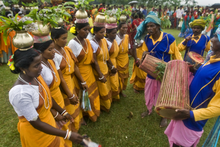Santhals

Santhali people at a dance Saontal
|
|
| Total population | |
|---|---|
| 6,850,000–6,950,000 | |
| Regions with significant populations | |
| Jharkhand | 2,410,509 |
| West Bengal | 2,280,540 |
| Bihar | 367,612 |
| Odisha | 629,782 |
| Nepal |
42,698 |
| Jhapa District | 23,172 |
| Morang District | 16,387 |
| Assam | 800,000-900,000 |
| Bangladesh | 271,485 (in 2012) |
| Languages | |
| Santhali | |
| Religion | |
| Sari Dharam • Sarnaism • Hinduism • Christianity | |
| Related ethnic groups | |
| Mundas • Hos • Kols • other Mon-Khmer people | |
42,698
The Santhal (Hindi: सांथाल, Bengali: সাঁওতাল, translit. shāñotāl, Nepali: सतार/सन्थाल, translit. satār/santhāl ) are a tribe of people indigenous to Terai of Nepal and India, who live mainly in Nepal and the Indian States of Jharkhand, West Bengal, Bihar, Odisha, Assam (part of the Tea Tribes). There is also a significant Santhal minority in neighboring Bangladesh, and a small population in Nepal. They are one of the largest tribal communities in India. The Santhal mostly speak Santali, a member of the Munda language family.
The Reverend J. Phillips published 'An Introduction to the Santal Language' in 1852, printed at the Calcutta School – Book Society's Press.
Lars Olsen Skrefsrud, a Norwegian missionary and a language researcher, published 'A Grammar of Santhali Language' in 1873.
Paul Olaf Bodding (born Gjøvik, Norway on 2 November 1865, died Odense, Denmark on 25 September 1938) was a Norwegian missionary, linguist and folklorist. He served in India for 44 years (1889–1933), and operated mainly from the town Dumka in the Santhal Parganas-district. Bodding created the first alphabet and wrote the first grammar for the Santhali-speaking native people in eastern India. In 1914 he also completed the translation of the Bible into the Santhali Language.
...
Wikipedia
